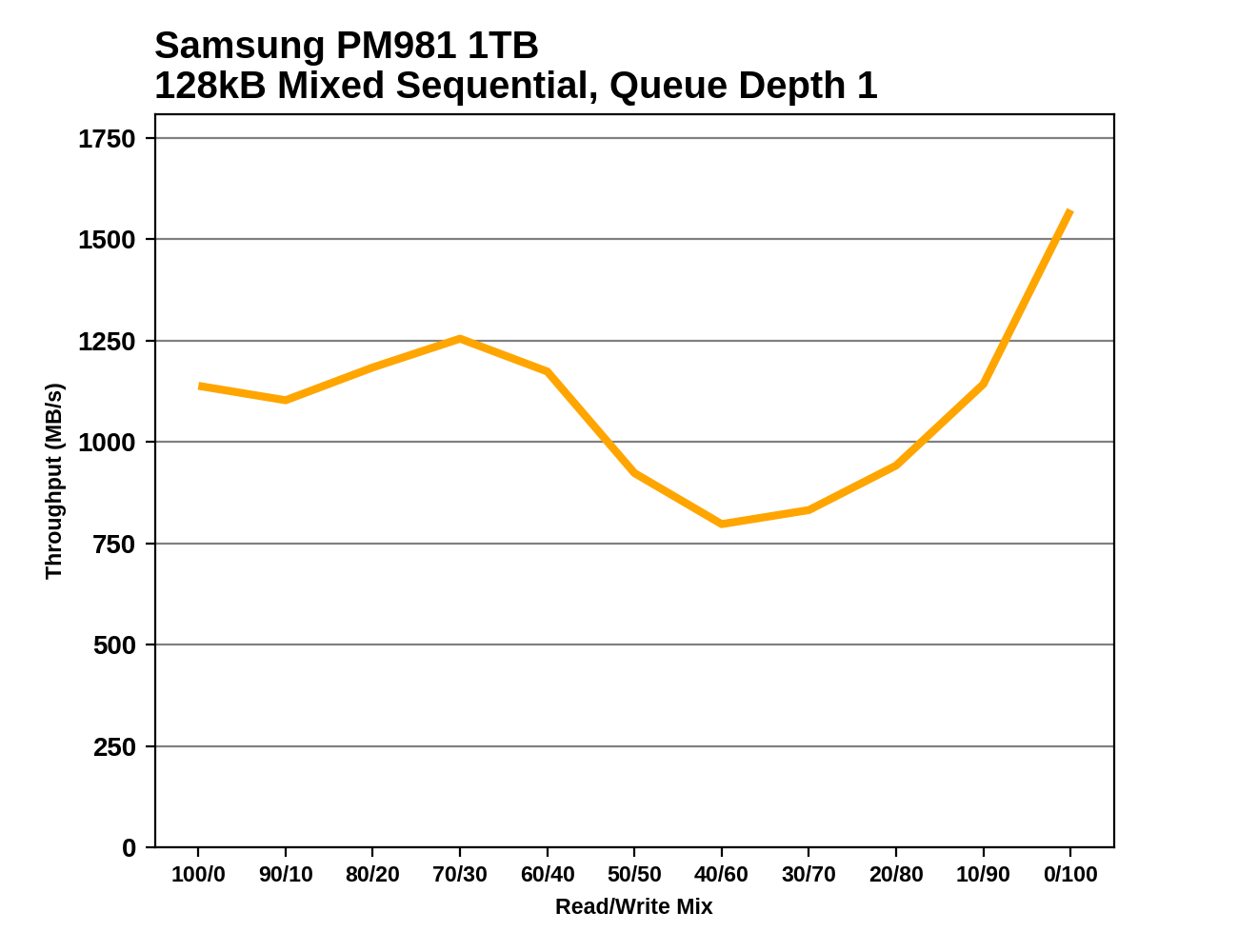The Samsung PM981 SSD Review (512GB, 1TB): Next Generation Controller And 3D NAND
by Billy Tallis on November 30, 2017 9:02 AM ESTMixed Random Performance
Our test of mixed random reads and writes covers mixes varying from pure reads to pure writes at 10% increments. Each mix is tested for up to 1 minute or 32GB of data transferred. The test is conducted with a queue depth of 4, and is limited to a 64GB span of the drive. In between each mix, the drive is given idle time of up to one minute so that the overall duty cycle is 50%.

The mixed random I/O performance of the Samsung PM981 is a big improvement over last generation's 960 EVO. The 1TB PM981 beats out even the MLC-based 960 PRO, while the smaller 512GB PM981 is a bit slower than the 960 PRO of the same size.
 |
|||||||||
As the proportion of writes in the mixed workload increases, the PM981 steadily gains performance, pulling further and further ahead of the 960 EVO. The 512GB PM981's main weakness is that its performance doesn't hit quit as high a peak during the final phases of the test when the workload is almost entirely random writes.
Mixed Sequential Performance
Our test of mixed sequential reads and writes differs from the mixed random I/O test by performing 128kB sequential accesses rather than 4kB accesses at random locations, and the sequential test is conducted at queue depth 1. The range of mixes tested is the same, and the timing and limits on data transfers are also the same as above.

The 512GB PM981 matches the mixed sequential performance of the MLC-based 512GB 960 PRO, while the 1TB PM981 is substantially faster than the 960 PRO or any other flash-based SSD.
 |
|||||||||
The Samsung 960 PRO 1TB outperforms the 1TB PM981 during the early read-heavy phases of the mixed sequential test, but then its performance drops off precipitously while the PM981 retains its performance until later in the test. The 512GB PM981 averages almost exactly the same performance as the 512GB 960 PRO, but with substantial differences in the details: the 960 PRO is faster at either end of the test, but the PM981 has a significant advantage for more even mixes of reads and writes.










53 Comments
View All Comments
skavi - Monday, December 4, 2017 - link
Lol, tech isn't wine. If people aren't working to improve it, it won't get better.skavi - Monday, December 4, 2017 - link
Lol, tech isn't wine. If people aren't working to improve it, it won't get better.WorldWithoutMadness - Friday, December 1, 2017 - link
that and ram oligopoly. Almost reminded me of intel before ryzen.Drumsticks - Thursday, November 30, 2017 - link
I doubt we'll see 1TB 3D XPoint in an m.2 form factor until at least the second generation of XPoint. Power consumption looks too high; you'd probably have to severely limit performance to get into m.2, or you'd need a massive unrealistic heatsink.UltraWide - Thursday, November 30, 2017 - link
Yes, the people want to see 900p destroy these benchmarks!! :)romrunning - Thursday, November 30, 2017 - link
I would love to see the Optane 900p results included as well.peevee - Thursday, November 30, 2017 - link
Me too.mczak - Thursday, November 30, 2017 - link
I miss the power draw numbers.Drazick - Thursday, November 30, 2017 - link
I don't like those m.2 drives. Can't we have high bandwidth connection for 2.5 inch drives? It will have less thermal issues for desktop configurations.DanNeely - Thursday, November 30, 2017 - link
That's the barely gained any traction outside of enterprise U.2 connection.